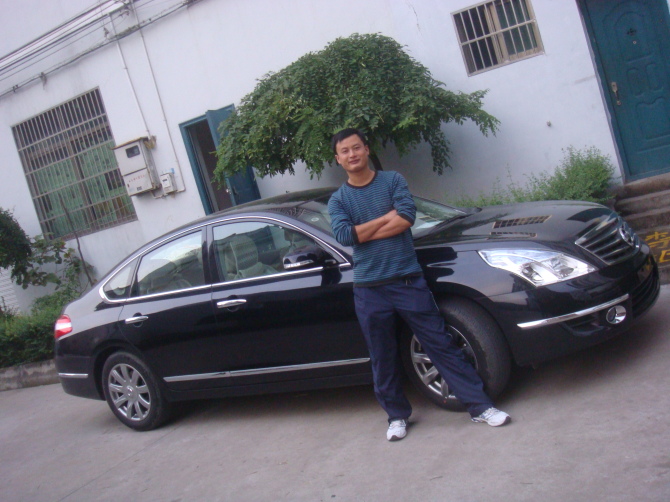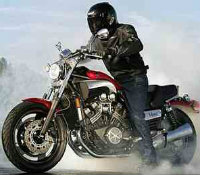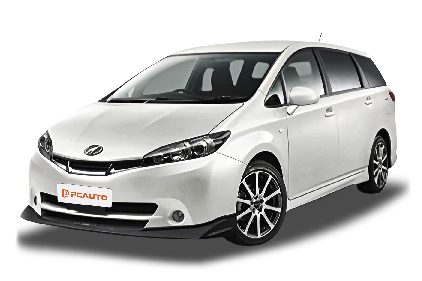Q
how much is toyota wish
So, let's talk about the Toyota Wish in Malaysia. First off, this model was discontinued back in 2017, so you won't find any brand-new ones on the market anymore. But if you're open to a used ride, there are still plenty floating around in the second-hand scene. Prices can vary a lot depending on the year, mileage, and overall condition—you're looking at roughly between RM30k to RM80k. For an early 2010s base model, you might pick one up for around RM30k to RM40k, while a top-spec 2015-ish model could set you back closer to RM70k to RM80k.
As a classic 7-seater MPV, the Wish has always been a hit with families here. Its durability, fuel efficiency, and flexible interior space make it super practical—perfect for big Malaysian households or folks who need to haul stuff around regularly. The 2.0L engine paired with a CVT gearbox offers a smooth drive and doesn't guzzle too much petrol, which is a big plus.
If you're scouting for a used Wish, here's my two cents: Pay extra attention to the CVT transmission condition and check for aging in the chassis rubber components. Also, it's worth asking if there's any remaining factory warranty—though that's rare on older units. Of course, newer alternatives like the Toyota Sienta or Honda BR-V are worth considering too; they come with updated tech and longer warranties. But the Wish still holds its ground with its tried-and-tested design and solid reputation in the market.
Special Disclaimer: This content is published by users and does not represent the views or position of PCauto.
Related Q&A
Q
How much fuel does a Toyota Wish use per km?
The fuel consumption of the Toyota Wish varies depending on the model year, engine displacement (such as 1.8L or 2.0L), and driving conditions. According to actual data, the combined fuel consumption of the 1.8L model is around 0.08 to 0.10 Malaysian Ringgit per kilometer (approximately 6.5 to 8.0 liters per 100 kilometers based on the current oil price). The 2.0L model has slightly higher consumption, about 0.10 to 0.12 Malaysian Ringgit per kilometer (8.0 to 9.5 liters per 100 kilometers).
The actual fuel consumption may be affected by road conditions, air - conditioning usage, and driving habits. For example, frequent rapid acceleration or traffic congestion in the city can significantly increase fuel consumption. It is recommended that car owners perform regular maintenance (such as replacing air filters and spark plugs) and maintain proper tire pressure to optimize fuel efficiency.
The oil price in Malaysia fluctuates greatly. You can refer to the fuel consumption test data published by MyJPJ or SPAD. Hybrid models are usually more fuel - efficient, but Toyota has not launched a hybrid version of the Wish. If you are considering energy - saving options, you can compare models in the same class, such as the Honda Jazz Hybrid or the Toyota Corolla Cross Hybrid.
Q
How many trims does the Toyota Wish have?
The Toyota Wish is available in three trim levels: the 2017 Toyota Wish 2.0L Z, the 2017 Toyota Wish 1.8L X, and the 2017 Toyota Wish 2.0L G. While these trims share many core features, there are some differences in specific details. For instance, the 2.0L Z weighs 1,420 kg, the 1.8L X weighs 1,340 kg, and the 2.0L G weighs 1,380 kg. In terms of seating capacity, the 2.0L Z offers six seats, whereas the 1.8L X and 2.0L G provide seating for seven. The body dimensions also vary slightly: the 2.0L Z measures 1,745 mm in width and 1,600 mm in height, while the 1.8L X and 2.0L G are 1,695 mm wide and 1,590 mm high.
Despite these differences, the three trims share several key specifications. All versions feature a CVT transmission, front-wheel drive, and an official combined fuel consumption of 6.9 L/100 km. Additionally, each model comes equipped with a comprehensive range of safety and convenience features.
Q
What is the maintenance schedule for Toyota Wish?
It is recommended that the Toyota Wish undergo regular maintenance every 6 months or every 10,000 kilometers, whichever comes first. This is the standard set by Toyota officially for the tropical climate and road conditions in Malaysia. Basic maintenance includes changing the engine oil and oil filter, inspecting the brake system, tire condition, and chassis components. Meanwhile, the air - conditioning filter needs to be cleaned or replaced regularly to cope with the hot and humid environment. The transmission fluid and brake fluid should be checked every 20,000 kilometers. It is advisable to replace the spark plugs and coolant at 40,000 kilometers, and special attention should be paid to the wear of the timing belt or chain at 60,000 kilometers. For Malaysian users, it is especially recommended to shorten the replacement cycle of the air filter, as the dusty environment will accelerate its clogging. It should be noted that the battery pack cooling system of the hybrid version of the Wish requires additional inspection, which is different from that of ordinary fuel - powered vehicles. Strictly following the maintenance manual can not only extend the vehicle's lifespan but also maintain fuel economy. Especially in the frequently congested road conditions in Malaysia, regular maintenance is particularly important for maintaining engine efficiency. If you often drive in coastal areas, you should also increase the frequency of chassis anti - rust inspections, as sea breezes can accelerate the corrosion of metal parts.
Q
How much engine oil does a Toyota Wish require?
The oil capacity of the Toyota Wish depends on the specific year and engine model. Take the common second - generation models from 2009 to 2017 in Malaysia as an example. The version equipped with the 2.0L 3ZR - FE engine usually requires about 4.2 liters of oil (including oil filter replacement), while the 1.8L 2ZR - FE engine needs around 3.8 liters. When actually adding oil, you should refer to the oil dipstick scale. It is recommended to use 5W - 30 fully synthetic oil that meets the API SN standard or higher.
It's worth noting that in Malaysia's tropical climate, you can consider using oil with a slightly higher viscosity, such as 5W - 40, to enhance high - temperature protection. However, you need to follow the suggestions in the original factory manual. Regular oil changes are crucial for engine maintenance. Generally, the oil needs to be changed every 5,000 to 10,000 kilometers or every 6 months. If you often drive short distances or idle for long periods, you should shorten the maintenance cycle. At the same time, I'd like to remind car owners to look for the JASO or ILSAC certification marks when purchasing oil to ensure the quality.
Q
What is the best engine oil for Toyota Wish?
For the Toyota Wish, the most suitable engine oils are 5W - 30 or 10W - 30 fully synthetic oils that meet Toyota's original factory standards. These two viscosities can provide excellent lubrication performance and fuel economy under Malaysia's climatic conditions. In particular, the high - temperature stability and oxidation resistance of fully synthetic oils are more suitable for tropical climates, and they can also extend the engine's service life. If the vehicle has high mileage (over 100,000 kilometers), you can consider using high - mileage oils such as 5W - 40 or 10W - 40 to provide better sealing. When choosing engine oil, make sure the product has API SN or SP certification and meets the ILSAC GF - 6 standard. These labels indicate that the oil has reached the current highest international performance standards.
It's worth noting that the oil change interval for the Toyota Wish is generally every 5,000 to 10,000 kilometers or 6 months, depending on driving conditions and the type of oil. Vehicles that often drive in congested urban traffic are recommended to shorten the change interval. Additionally, the quality of the original factory oil filter is more reliable, so it is recommended to replace it when changing the oil. Understanding this knowledge can not only help you better maintain your beloved car but also avoid engine wear problems caused by using improper oil.
Q
What are the advantages of the Toyota Wish?
As a classic 7-seater MPV, the Toyota Wish is highly popular among family users in the Malaysian market. Its advantages mainly lie in practicality and reliability. The spacious and flexible cabin space, combined with the foldable third-row seats, can easily meet the needs of family outings or cargo transportation. The 1.8L and 2.0L Dual VVT-i engines strike a balance between fuel economy and power performance, making them suitable for Malaysia's diverse road conditions.
In addition, Toyota's well-established after-sales service network in the local area and the high resale value of its used cars have also reduced the long-term usage cost. It's worth mentioning that the air - conditioning cooling efficiency of MPV models is particularly important in Malaysia's hot climate, and the Wish's independent rear - row air - conditioning vents are designed with this in mind.
Although there are more new models emerging in the market today, the Wish, with its time - tested durability, remains a practical choice for budget - conscious families. It is especially suitable for users who need to pick up and drop off children frequently or run small businesses.
Q
What type of car is the Toyota Wish?
The Toyota Wish is a sporty MPV. This type of vehicle combines the spatial flexibility of an MPV with the driving experience of a sports car, offering users a unique driving option. The Toyota Wish has a length of 4,590mm, a width ranging from 1,695 to 1,745mm, a height between 1,590 and 1,600mm, and a wheelbase of up to 2,750mm. Its size design makes the interior space spacious and practical. It comes in a 5-door layout with either 6-seat or 7-seat configurations. The rear seats are split and foldable, meeting different needs for passenger-carrying and storage during travel. In terms of power, it offers a choice between 1.8L and 2.0L gasoline engines, paired with a CVT transmission and front-wheel drive, ensuring smooth power delivery during daily driving. Regarding safety features, it is standardly equipped with systems such as ABS anti-lock braking, lane departure warning, and active braking, along with 8 airbags, providing reliable safety protection for both drivers and passengers.
Q
What is the safety rating of the Toyota Wish?
The Toyota Wish performs averagely in safety ratings. According to past test records, this model has achieved above-average results in safety assessments in some regions. However, the specific ratings may vary depending on different testing agencies and model years. In the Malaysian market, the Toyota Wish is favored by many family users for its practical space and reliability. It should be noted, though, that earlier models may not be equipped with the latest active safety technologies, such as automatic emergency braking or lane-keeping assist. For safety-conscious consumers, it is recommended to thoroughly understand the safety equipment of the specific year and configuration before purchasing. You can also refer to the data of regional safety evaluation institutions like ASEAN NCAP. The road conditions in Malaysia are diverse. Whether you're driving in the city or on a long trip, it's extremely important to choose a vehicle with good safety performance. Besides paying attention to crash ratings, daily vehicle maintenance and safe driving habits should not be ignored either.
Q
Does Toyota Wish have a timing belt or chain?
The models of the Toyota Wish launched in the Malaysian market are mainly equipped with 1.8 - liter and 2.0 - liter gasoline engines. Both of these two engines adopt the timing chain design instead of the timing belt. The advantage of the timing chain is that it has a longer lifespan. Usually, it can last for the entire life cycle of the engine without replacement, which reduces the long - term maintenance cost. On the other hand, the timing belt needs to be regularly inspected and replaced at around 60,000 to 100,000 kilometers to avoid the risk of breakage. For Malaysian car owners, the timing chain is more suitable for the local hot and rainy climate because it has better resistance to high temperatures and humidity. However, it is still recommended to regularly check whether the chain tensioner is working properly. It should be noted that although the chain is maintenance - free, if the engine makes abnormal noises (such as metal friction sounds), it should be repaired in time, which is the same for all models with chain - driven systems. In addition, car owners can further confirm the specific configuration through the vehicle manual or the markings in the engine compartment. There may be slight differences in the Wish models of different years.
Q
How fast is Toyota Wish?
The Toyota Wish is a popular 7-seater MPV in Malaysia. Its power performance depends on the specific model and engine configuration. The early models are equipped with 1.8-liter or 2.0-liter naturally aspirated engines. The 1.8-liter version has a maximum horsepower of about 132 hp, while the 2.0-liter version can reach about 141 hp. It takes about 10-12 seconds to accelerate from 0 to 100 km/h, and the top speed is about 180-190km/h. It's suitable for family use. Although it's not known for its sporty performance, the smooth CVT transmission and comfortable suspension tuning make it perform well in city driving and long-distance trips. It's worth noting that the design of this kind of MPV focuses more on space utility and fuel economy rather than ultimate speed. For Malaysian consumers, the reliability and low maintenance cost of the Wish are also important reasons for its popularity. If you have higher requirements for performance, you can consider the sporty models of the same brand. But as a family car, the Wish strikes a good balance between power and practicality.
Popular Cars
Model Year
Car Compare
Car Photo
Latest Q&A
Q
How much is the 2024 Vanquish?
The specific selling price of the 2024 Aston Martin Vanquish has not been officially announced yet, but based on the market positioning of the previous generation model and supercars in the same class, the starting price is expected to be between RM1.5 million and RM2 million, and the specific price will fluctuate depending on optional configurations and tax rates. As Aston Martin's flagship GT sports car, Vanquish is typically equipped with a V12 engine with a power output of over 600 horsepower, and features a carbon fiber structure and luxurious handmade interior that balances performance and comfort. It should be noted that these high-end sports cars often require advance booking and long delivery cycles. It is recommended to directly contact authorized dealers for the latest information, including customization options and financial solutions. In the same price range, models such as Ferrari Roma or Bentley Continental GT can also be considered, each with its own characteristics. For example, Roma leans more towards sporty handling, while Continental GT emphasizes luxury travel experience, and consumers can choose according to their own needs.
Q
What engine is in the Vanquish 2024?
The 2024 Vanquish is expected to pack a fortified 5.2-liter V12 twin-turbocharged engine, sourced from Aston Martin’s flagship powertrain lineup. With power likely bumped to around 700 horsepower and torque peaking at 800 Nm, it’s paired with an 8-speed automatic transmission—balancing blistering performance with seamless shifts.
The aluminum block and twin-scroll turbos keep weight in check while sharpening throttle response, and cylinder deactivation helps with fuel efficiency when you’re not chasing the horizon. As Aston’s GT flagship, the Vanquish’s tuning prioritizes low-end grunt, making it equally at home on cross-country hauls or twisty mountain passes.
Worth noting: these big-displacement turbo engines handle tropical climates with ease, thanks to cooling systems specifically tweaked for high-temperature resilience—critical when pushing hard. For those craving extra edge, optional carbon-ceramic brakes and rear-wheel steering dial up the agility, ensuring composure even when the roads get unpredictable.
Q
What does a 2024 Aston Martin cost?
The 2024 Aston Martin lineup sees significant price variations depending on model and specifications. The entry-level Vantage starts at approximately RM1 to 1.2 million, while the DB12 ranges between RM1.5 to 1.8 million. Flagship performers like the DBS 770 Ultimate or limited-run Valhalla can easily surpass RM3 million. These figures typically cover base configurations, though costs rise with optional performance packs, bespoke interiors, or specialty paintwork.
As a handcrafted British luxury marque, Aston Martins feature either uprated 4.0L V8 twin-turbo or 5.2L V12 powertrains, paired with cutting-edge tech like intelligent suspension and digital cockpits. Buyers should consult authorized dealers for exact configurations—the brand’s personalization program allows extensive customization of materials and finishes.
Pro tip: Factor in elevated insurance and maintenance costs. These high-performance machines follow specialized service schedules, so review aftersales policies beforehand. Always confirm final pricing with your dealer, as options dramatically impact the bottom line.
Q
How much is the 2024 Aston Martin Vanquish?
The specific selling price of the 2024 Aston Martin Vanquish has not yet been officially announced by the official, but based on the pricing strategy of the previous generation model and brand, it is expected that the starting price will remain in the range of 300000 to 400000 US dollars, and the specific price will be adjusted according to optional configurations and exchange rate fluctuations. As the flagship GT sports car of the brand, Vanquish continues the classic British design language, equipped with an enhanced V12 engine with a maximum power of over 600 horsepower, and equipped with a new generation of adaptive suspension and carbon fiber body technology, achieving a balance between luxury and performance. It is worth noting that these ultra luxury models are usually produced on an order basis with a long delivery cycle. It is recommended to obtain customized quotes through authorized dealers. Competitors in the same class include Ferrari Roma and Bentley Continental GT, but Vanquish emphasizes the combination of long-distance comfort and driving pleasure. Its iconic grille design and hand sewn interior craftsmanship also continue the brand's unique recognition.
Q
Does the 2019 Kia Cerato have Apple CarPlay?
The 2019 Kia Cerato did come equipped with Apple CarPlay, which was a pretty standard tech feature for its class at the time. It lets you mirror your iPhone’s navigation, music, and calls onto the car’s display via USB—handy for keeping things safe and convenient on the road. Android Auto was also onboard, so it covered both major phone ecosystems. The 8-inch touchscreen was responsive, with a clean interface that made it easy to use.
Just a heads-up: for the best CarPlay experience, make sure your iPhone’s OS is compatible and use an original cable. Back in 2019, rivals like the Toyota Corolla and Honda Civic offered similar tech, but the Cerato stood out for its value, especially if you wanted solid features without overspending. If you run into any hiccups with CarPlay, the owner’s manual or a dealership visit should sort you out.
View MoreRelated News

Toyota Raize: When will this smart and compact SUV be available in Malaysia?
AshleyDec 2, 2025

Why is the Toyota Sienna so popular with so many people?
RobertDec 1, 2025

Toyota unveils the new Corolla at the Auto Guangzhou in China. What changes will the future Corolla have?
AshleyNov 25, 2025

Why is the facelifted GR Yaris considered the finished product?
AshleyNov 21, 2025

Toyota is developing two new Land Cruiser models, will Land Cruiser become an independent brand in the future?
JamesNov 20, 2025
View More


















Pros
Cons